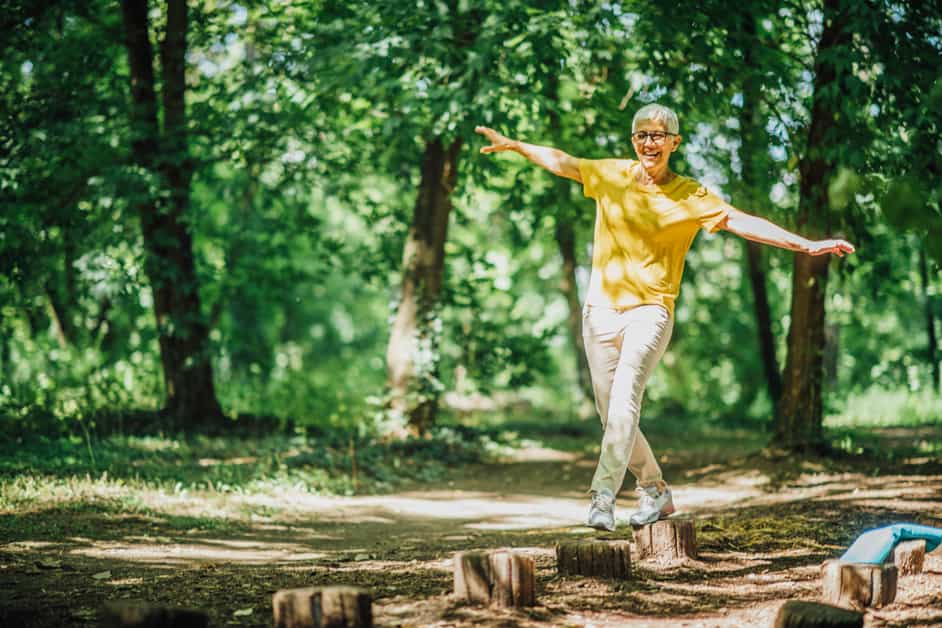Understanding Knee Pain
Knee pain has many causes. It can come from an injury, a medical issue, or problems with the muscles and joints around the knee. To find relief, it’s important to figure out what is causing the pain.
Exercise is key for managing pain. Knowing the root cause of the pain is the initial step to have fun and stay active. Balance training is a great way to do this.
Identify the cause of knee pain
Knee pain can be caused by several factors, including an injury, osteoarthritis, or normal aging. To find the best treatment, it is important to identify the cause.
Injury-related knee pain can be due to muscle strains, tendonitis, meniscus tears, ligament tears, dislocated kneecaps, or fractures. Osteoarthritis is caused by worn joint cartilage, which leads to swelling, stiffness, and bone spurs that cause pain. Rheumatoid arthritis can also lead to pain, as it affects the synovial membrane that lines and lubricates the joint. With age comes wear and tear on the cartilage that cushions the bones in our knees, which can lead to chronic pain or disability if not managed.
Exercises, such as balance training, can help reduce aches and pains. Stretching can help increase flexibility. If you choose to do balance exercises, start slow until your body adjusts. Examples are:
- Shifting weight while standing, or
- Duplicating motions while seated on a chair, rather than standing up.
This can reduce stress on the knees. Yoga is great for strengthening muscles around joints and gently stretching out tight areas, to increase mobility and reduce pressure on painful areas. It’s low-impact and not too boring.
Understand the types of knee pain
Knee pain can have different causes, such as:
- Osteoarthritis occurs when the protective covering on bones wears away, causing bones to rub against each other. This may lead to pain and stiffness, especially after a period of no activity.
- Tendinitis is inflammation of a tendon. It leads to swelling and tenderness or painful knots in the joint.
- Bursitis is inflammation of bursa, which are small sacs filled with lubricating fluid. This causes pain and swelling.
- Patellofemoral syndrome is characterized by irritation under the kneecap. This can cause aches, sharp or stabbing pain behind the kneecap.
- Meniscus injury involves two C-shaped pieces of cartilage between the thigh bone and shin bone. It can cause clicking/popping sensations and difficulty extending/bending the knee joint.
It’s essential to diagnose the type of knee injury to address it properly. Consulting a doctor is recommended before beginning any exercise program for knee issues.
Balance Training Basics
Balance training is essential for knee pain rehabilitation. It strengthens leg muscles, improves balance, coordination and posture. But it can be dull and tedious! Let’s make it fun and stimulating instead.
Here’s how to tailor balance training for those with knee pain in an enjoyable and effective way:
Types of balance exercises
Balance exercises are an excellent way to improve your physical and mental balance. They can help you with coordination, neuromuscular control, and stronger hip and core muscle strength.
There are many different types of balance exercises. Static balance exercises require you to hold a position for a certain amount of time. For example, stand on one foot on an even surface, with the other foot off the ground. Or, do an isometric wall-sitting position, with feet forward and hip-width apart.
Dynamic balance training improves motor control and body awareness while moving. Examples include crossover jabs for boxing drills, alternating lunges for single leg strengthening and hopscotch patterns for sport training.
Proprioception exercises develop awareness of how the body moves in space without using conscious thought or muscle memory. Examples include catching yourself weighting an unstable object without looking at it, or catching something thrown by another person, such as medicine balls with a partner. This helps you become aware of your location.
Benefits of balance training
Balance training is key to avoiding and treating orthopedic injuries, particularly those affecting the knee. Its main advantage is improved stability and flexibility. As muscles around the knee are challenged with exercises that involve quickly and safely changing positions to keep balance, they become stronger and more stable. This shields against future joint problems, and aids those with existing injuries to heal faster. It also bolsters good posture, which decreases pain when doing daily activities.
Additional advantages of balance training include:
- More confidence in physical abilities;
- Better coordination, agility and spatial awareness;
- Increased strength and power;
- Reduced risk of falls among elderly;
- Improved physical condition for athletes;
- Enhanced overall balance in daily life.
Balance training can be done with or without gear, so it’s a great way to customize workouts for individual needs. By making slow moves that challenge brains and bodies during each session, we can make exercise fun and develop the essential aspects of good balance – body control and intelligence. Thus, balance training is not only beneficial, but fun too, with long-term advantages for users.
Safety Tips
Knee pain sufferers must be careful when doing balance training. Precautionary steps need to be taken to protect the joint. Here are some safety tips to remember:
- Take special care during balance activities.
- Have the correct safety gear ready.
Use appropriate footwear
Choosing the right shoes and supportive accessories is essential for balance exercises. Shoes with cushioning, arch support, shock-absorption and flexibility are vital for knee pain sufferers. Trail running shoes or cross trainers are recommended for balance training because of their additional ankle stability. Workout clothing such as leggings or sweatpants made out of snug-fitting stretch fabric or spandex will also ensure comfort and movement.
For those with knee or joint pain, wearing a supportive brace or wrap around their knees to stabilize the area during exercises is especially important. Extra precautions such as applying supportive wraps may help reduce injury risk and provide ache relief.
Warm up before exercise
It’s essential, especially for those with knee pain, to warm up their body before any exercise. Warming up increases blood flow and body temperature, while also improving cognitive performance. A few minutes of light exercises will help you get the most out of your workout.
Dynamic stretching is the best way to warm up before balance training. Doing stretches that replicate the upcoming movements can stretch and activate muscles while heating your body. Examples are marching in place and using arm and leg circles. Avoiding static stretching will ensure your muscles stay loose during the activity.
Dynamic warm-up exercises should be done for 5 minutes at a light intensity level. This will stimulate blood circulation and reduce joint compression which could cause pain during activity. Examples include:
- Jogging on the spot
- Stepping side-to-side with alternating knees forward
- Arms moving in alternating clockwise & counterclockwise circles
- Forward folds with arm circles overhead
Choose the right surface
Balance Training for knee pain? Make sure you do it safely!
- Choose the right surface. Carpeted ones are great for cushioning and grip, but go for low-pile. Hardwood has most movement contact and support, but can be slippery if you sweat. Rubber surfaces offer excellent grip, but limit inbound movements.
- Pick one with consistent layout across a flat plane. If uneven or broken, make sure it’s fitted properly.
- Wear non-slip shoes with arch support for a good foundation and connection between feet and floor. This is key for optimal safety benefits for knee pain sufferers!
Making Balance Training Fun
Balance training is vital for those with knee pain. To avoid boredom, get creative! Here are some fun and challenging ways to make balance training enjoyable. Let’s explore some of them!
Use props to increase difficulty
Props can be great when balance exercises become too easy. Use a pillow, yoga block, or a BOSU ball to make the exercise more challenging. BOSU balls are perfect for adding dynamic components. Balance training doesn’t have to be boring – use props to add excitement!
Vary motions – increase range of motion, change direction with weight-bearing activities. Use exaggerated motions for more stability. Move faster for less support if you want a bigger challenge. Keep in mind how movements help you become stronger and healthier. Challenges should be enjoyable!
Incorporate games and competitions
When doing balance training for people with knee pain, make it fun! Boredom can stop people from exercising. To keep patients motivated, create games. For instance, try a game of horseshoes with bean bags on a balance disc or Bosu ball. Make it a competition by adding multiple players. They can compete to be the first to stand on one foot, reach something on the other side of the room while balancing, or throw objects into a spinner barrel. Competing with friends can help with determination and focus.
Finding mistakes during the activity will help to improve balance, agility, and coordination – all of which are important for strong knees.
Use music to keep it fun
Music is a great way to keep balance training fun for those with knee pain. It can improve your mood, keep you focused and help you monitor pace and intensity. Upbeat, energizing songs with steady beats are suitable for heel-to-toe walking and single leg stands. Slower recovery songs can be used to cool down and coordinate between sets.
Mix up the music every session, and add props like ribbons or scarves for extra fun! Smartwatches and fitness trackers with audio functions can also be useful for controlling music for a personalized workout.
Challenges
Balance training is an excellent exercise for those with knee pain. It strengthens the muscles that support the knee. Unfortunately, it can become dull quickly, leading to a lack of motivation.
To make balance training more interesting, it’s important to vary the activities. Here are some ideas for making it fun and challenging:
- Incorporate different props, such as stability balls, foam rollers, and balance discs.
- Do single-leg exercises, such as single-leg squats, lunges, and calf raises.
- Try exercises that require you to balance on one foot while reaching or lifting with the other hand.
- Include exercises that require you to balance on an unstable surface, such as a Bosu ball or balance board.
Increase the time of exercises
For those with knee pain, balance training can be more fun and difficult. Start by picking a few exercises that focus around your knee – both static and dynamic. Set a timer that’s longer than what you can currently do. As you get better, increase the time you spend on them. This lets you challenge yourself in a safe way.
If you want activities that need more flexibility, use props like cones or wobble boards. These help engage different muscle groups, letting you do more than you can now. Have consistent practice and track your progress. Then, you can make balance training both challenging and enjoyable!
Increase the number of repetitions
To make balance training more challenging, increase the number of repetitions. When beginning, use low-impact stability exercises that don’t need all your bodyweight on the knees. These include balance boards, balance discs, wobble cushions and bosu balls.
Once you have a basic level of stability, gradually increase the duration and complexity of movement. If doing calf raises on a step bench, hold one second at the top and add one calf raise a session until you reach 15.
To make balance training more difficult, change the base of support for certain exercises. Try single-leg workouts with two feet added (on two mats instead of one), or balance weight evenly on two foam pads instead of a steady surface. These small changes can challenge and improve balance without much impact on the knee joints.
Increase the range of motion
Flexibility in your body can help boost performance and cut down on injuries. ROM (Range of Motion) is the amount a joint can move and it is important for athletes in tennis, golf, baseball, basketball and soccer.
Here’s how to increase ROM:
- Do dynamic stretching before any activity. This will loosen tight muscles and you’ll be all set for the activity.
- Use foam rollers or lacrosse balls for myofascial release. This helps get rid of adhesions that can form after physical activity or long periods of sitting or standing still.
- Do static stretches after exercising. These include lunges, child’s pose, and downward-facing dog. These will help cool the body down, as well as give your ROM a boost.
- Incorporate yoga into your routine. This is a great way to work out different tension spots. If you hold poses for two minutes, you’ll increase flexibility and circulation.
- Try assisted stretching exercises with elastic tubing. This will help strengthen the areas while making them more flexible.
Frequently Asked Questions
Q1. What kind of balance training is best for knee pain sufferers?
A1. Balance training that is tailored to the individual patient’s needs is best for knee pain sufferers. Depending on the severity of the pain, low-impact exercises such as squats, lunges, and single-leg stands can be used to help strengthen the muscles around the knee and improve balance.
Q2. Are there any special considerations for balance training for knee pain sufferers?
A2. Yes, it is important to be aware of any pain or discomfort during balance training exercises, as this could indicate that the exercise may be too difficult or that the form is incorrect. It is also important to start slowly and increase the difficulty of the exercise as the patient’s strength and balance improves.
Q3. What activities can be used to make balance training fun and challenging for knee pain sufferers?
A3. Activities like walking on an uneven surface, using a balance board, or playing balance-focused games like carpet bowling can be used to make balance training fun and challenging. It is also important to vary the exercises to keep the patient engaged and motivated.





